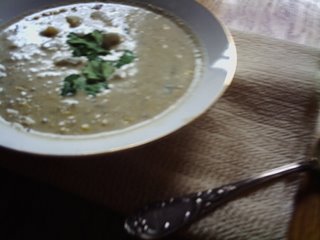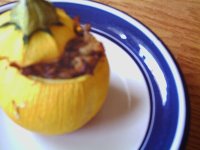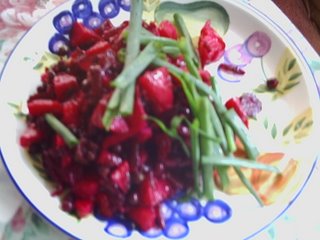
I take back everything I
said about how expensive eating local is. For the past month and a half I've been buying almost all my produce at
one of the local farmer's markets and most of the the vegetables there are
cheap. You can get eight zucchinis for a dollar. A whole basket of excellent, firm cucumbers for two bucks. Three pounds of excellent tomatoes for $5.
But does locally grown food taste better than supermarket produce? Some snap judgments of veggies I buy almost every week:
Tomatoes: Incomparably better than store tomatoes, of course. Still, I've had more than a couple of starchy farmer's market tomatoes.
Corn: So sweet that I wouldn't mind having it for dessert, with butter.
Zucchini and yellow squash: Unlike pallid supermarket squash, farmer's market squash is a deep, golden yellow. I also like round squash, which I've never even seen at the supermarket. I can't tell much of a difference in taste between farmer's market squash and store squash, though. Maybe I should taste test raw zucchini.
Potatoes: I've only tried the fingerling potatoes so far, but they just might be the best potatoes I've ever had. I can eat them like candy with a little salt and sour cream.
Cucumbers: I love tiny, super-firm, super-crunchy farmer's market cukes. I often eat them as a pre-dinner snack while cooking.
Carrots: Pretty good, but not as flavorful as I would like them to be. I've had sweeter bagged baby carrots.
Radishes: Farmer's market radishes used to be almost too spicy for me. Then I had a couple of store radishes, and they tasted so bland and blah in comparison.
Green beans, broccoli and eggplant: Damned if I can tell the difference between farmer's market versions and the stuff I buy at the grocery store in January.
There's something very pleasurable and even sensual about shopping at the farmer's market. Ripe tomatoes glisten in the sun like odalisques in an Ingres painting. You can smell fresh dill, basil and cilantro from afar. If you go to a big and crowded farmer's market, like I do, you will feel a kind of happy mood, an overall sense of well-being in the air.
That said, I'm not a total convert to the
Eat Local movement. There's something a little facetious about giving up spices, coffee, tea and non-local fruits and vegetables. Foodies in the '60s and '70s fought and died so we could have Middle Eastern couscous, olive oil from Italy, and cheese from France. Why you'd want to give that stuff up as a matter of principle, I have no idea. So I will shop at the farmer's market while I can, just because most of their produce tastes better and is cheaper. Come November, I'll be back at the soulless big mart, stocking up on vegetables from God knows where.
Corn Chowder--I bought far too much corn on the cob last week so I made corn and roasted poblano chowder. This recipe is adapted from the
Williams Sonoma Everyday Roasting cookbook.
You toast a tablespoon of
cumin seeds in a frying pan until they become aromatic. Add the cumin seeds, along with a couple of
chipotle chilies (I used
jalapeno), a
bay leaf and 1/4 teaspoon of
rosemary (I used
thyme) to four cups of
milk. Bring the milk to a simmer, but don't boil. Take off the heat, cover, and let stand for 20 minutes.
Meanwhile, broil a couple of
poblano chilies (the recipe called for 3; I only had 1 on hand) until their skin is black. Let cool; then peel and remove stems, seeds, etc. Dice and set aside. In a heavy stockpot, sauté a chopped
onion in
olive oil and
butter. Salt to taste. Add a crushed
garlic clove, a teaspoon of
ground cumin, and cook for 5 minutes. Then add kernels from 4 ears of farmer's market
corn and the poblano chilies. Cook for 5 more minutes. At this point I added a couple of cooked, diced
potatoes. The recipe didn't call for them, but they weren't amiss.
Strain the milk through a sieve into the corn and onion mixture. Simmer for 15 minutes. Puree 1/3 of the soup in a blender or food processor, and add it back to the stockpot. The suggested garnish is chopped
scallions, but I used a little chopped
parsley and crumpled
feta.

























